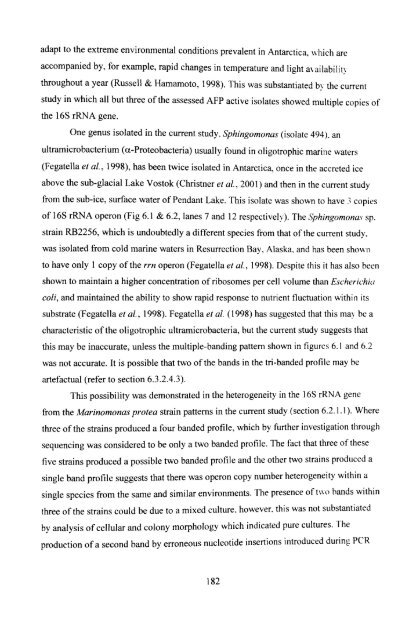ý.,,: V. ý ýý . - Nottingham eTheses - University of Nottingham
ý.,,: V. ý ýý . - Nottingham eTheses - University of Nottingham
ý.,,: V. ý ýý . - Nottingham eTheses - University of Nottingham
Create successful ePaper yourself
Turn your PDF publications into a flip-book with our unique Google optimized e-Paper software.
adapt to the extreme environmental conditions prevalent in Antarctica, which are<br />
accompanied by, for example, rapid changes in temperature and light availability<br />
throughout a year (Russell & Hamamoto, 1998). This was substantiated by the current<br />
study in which all but three <strong>of</strong> the assessed AFP active isolates showed multiple copies <strong>of</strong><br />
the 16S rRNA gene.<br />
One genus isolated in the current study, Sphingomonas (isolate 494), an<br />
ultramicrobacterium<br />
((x-Proteobacteria) usually found in oligotrophic marine waters<br />
(Fegatella et al., 1998), has been twice isolated in Antarctica, once in the accreted ice<br />
above the sub-glacial Lake Vostok (Christner et al., 2001) and then in the current study<br />
from the sub-ice, surface water <strong>of</strong> Pendant Lake. This isolate was shown to have 3 copies<br />
<strong>of</strong> 16S rRNA operon (Fig 6.1 & 6.2, lanes 7 and 12 respectively). The Sphingomona, s sp.<br />
strain RB2256, which is undoubtedly a different species from that <strong>of</strong> the current study,<br />
was isolated from cold marine waters in Resurrection Bay, Alaska, and has been shown<br />
to have only 1 copy <strong>of</strong> the rrn operon (Fegatella et al., 1998). Despite this it has also been<br />
shown to maintain a higher concentration <strong>of</strong> ribosomes per cell volume than Escherichia<br />
coli, and maintained the ability to show rapid response to nutrient fluctuation within its<br />
substrate (Fegatella et al., 1998). Fegatella et al. (1998) has suggested that this may be a<br />
characteristic <strong>of</strong> the oligotrophic ultramicrobacteria, but the current study suggests that<br />
this may be inaccurate, unless the multiple-banding pattern shown in figures 6.1 and 6.2<br />
was not accurate. It is possible that two <strong>of</strong> the bands in the tri-banded pr<strong>of</strong>ile may be<br />
artefactual (refer to section 6.3.2.4.3).<br />
This possibility was demonstrated in the heterogeneity in the 16S rRNA gene<br />
from the Marinomonas protea strain patterns in the current study (section 6.2.1.1). Where<br />
three <strong>of</strong> the strains produced a four banded pr<strong>of</strong>ile, which by further investigation through<br />
sequencing was considered to be only a two banded pr<strong>of</strong>ile. The fact that three <strong>of</strong> these<br />
five strains produced a possible two banded pr<strong>of</strong>ile and the other two strains produced a<br />
single band pr<strong>of</strong>ile suggests that there was operon copy number heterogeneity within a<br />
single species from the same and similar environments. The presence <strong>of</strong> two bands within<br />
three <strong>of</strong> the strains could be due to a mixed culture, however, this was not substantiated<br />
by analysis <strong>of</strong> cellular and colony morphology which indicated pure cultures. The<br />
production <strong>of</strong> a second band by erroneous nucleotide insertions introduced during PCR<br />
182
















